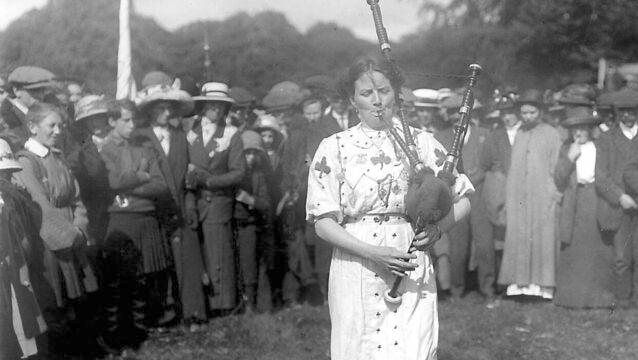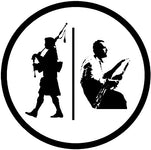
Nance The Blind Piper From Castlelyons
“Nance the blind piper“ from Castlelyons, County Cork, was yet another not so famous Irish bagpiper who made a living or pass time from playing bagpipes, in spite of the challenges of being blind. She also had a reputation of being a fun character who enjoyed having banter with other musicians and especially dancers.
Thankfully, there are a few written articles on her and surviving folklore from East Cork. However no one can still confirm what her family surname was. We can be thankful to the anecdotes surviving from the old Cork Pipers Club and some surviving stories from local pipers and historians in Castlelyons.
Nance spent a lot of her bagpiping time with Irish dancers and was reported to have had a heightened musical connection with them in spite of, or because of her blindness. She was a gifted tin whistle player but the Piob Mór was her preferred musical instrument for outside dancing or "crossroads dancing" which was a common and ancient tradition in Gaelic Ireland.

“Nance The Piper from Castlelyons“ performing in Cork City, 1926
It is quite notable in Ireland that we have many examples of both Uilleann pipers and Piob Mór pipers over the centuries who mastered the art of playing our bagpipes even though blind. The story of Nance from Castlelyons is worthy of being added to the list.

Above is an outline of County Cork, Ireland, with the traditionally extra strong piping area of East Cork / Castlelyons / Fermoy highlighted in white.
Castlelyons and East Cork: A hot bed of bagpipes in Ireland
The village and area of Castlelyons in east County Cork, where Nance was from, had a high density of bagpipers. It is said you could not throw a stone in Castlelyons without hitting a piper or drummer. It was also interesting that in many townlands there were often as many female bagpipers as male. This tradition continued even up until the last few decades with Castlelyons Pipe Band among others in the East Cork and Fermoy area having lots of female pipers.

Thomas Kent Girls Pipe band, Fermoy, East Cork, early 1960's. Girls names from L/R: Creenie Hull, Chrissie Coughlan, Abina Hull, Linda Hull, Mary Coughlan and Ann Coughlan (all cousins)

Pictured on the cover of "Columbia" magazine in the USA in 1960, are Piper Helen Bowes and Drummer Mary Bowes from the Oliver Plunkett Girls Pipe Band of Fermoy County Cork.

Fermoy Pipers Club, County Cork, 1915. Most of the pipes were two drones and one of the pipers had a set made in Cork from the 1800's
Gaelic Culture: Nance, an echo of an older culture
In old Irish culture, when the Gaelic families held sway in Ireland, the wandering minstrels, poets and musicians were highly regarded in Irish society. So much so that they would have been accommodated, fed and looked after in the places and houses they performed at. This custom still carried on into the late 1800's and early 1900’s.
Nance spent at least some of her time living like this. Maybe for someone with a challenge like blindness it was a natural choice to take up music, singing or performing of some kind to make a living. So it seems to be, in the case of Nance the piper from Castlelyons.
Nance was a widow who lost her husband in the 1890’s. With the added affliction of blindness, she overcame this condition to become a renowned musician. Her deceased husband was also said to be a Warpiper .

Castlelyons, County Cork, showing the townland of "Mohera" where it is believed Nance came from.

Nance The Piper from Castlelyons“ performing at a Feis (Irish Music Festival) at the Mardyke, Cork City, in July, 1926
Lets not Forget the story of Nance from Castlelyons
Along with surviving local folklore about Nance in her native Castlelyons, there were stories recalled from the Cork Pipers Club, through John Wayland and Jimmy Barry. Nance was quite a character according to Jimmy Barry and as well as playing pipes she could also sing a song and tell a good story.
Jimmy Barry’s description of the blind female musician reached the ears of the famed Francis O’Neill in Chicago. O’Neill was the famous Bantry-born Irish music collector and also Chief of Police in Chicago from 1901 to 1905, he mentioned her in his 1913 publication “ Irish Minstrels and Musicians “.
All those who wrote of her agreed that only the best pipers were capable of playing for the dancers who gathered on stage or at cross-roads platforms. Without a blink of light in her eyes, she was able to discern each Irish step-dancer by the sound of his or her feet.
Like is often the case with pipers and the history of Piob Mór na hÉireann itself, Nance never became famous or wealthy from her piping and was not heard in the fine buildings of Cork or Dublin or elsewhere in Ireland.
To quote Francis O’Neill, who was evidently much taken with the stories he heard of her, remarking that "A character so quaint and unique as this blind woman piper, if "Jimmy" Barry's story be true, should have been immortalized in Irish literature."

Leave a comment